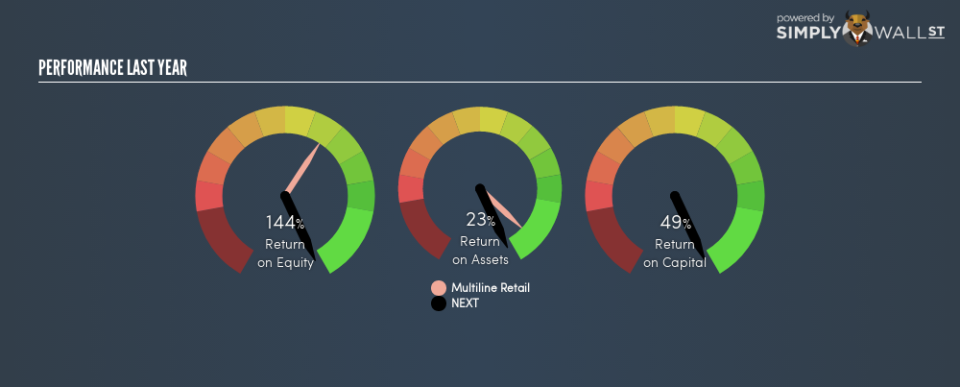NEXT plc (LON:NXT) Earns A Nice Return On Capital Employed

Today we are going to look at NEXT plc (LON:NXT) to see whether it might be an attractive investment prospect. Specifically, we’ll consider its Return On Capital Employed (ROCE), since that will give us an insight into how efficiently the business can generate profits from the capital it requires.
First up, we’ll look at what ROCE is and how we calculate it. Next, we’ll compare it to others in its industry. Last but not least, we’ll look at what impact its current liabilities have on its ROCE.
Understanding Return On Capital Employed (ROCE)
ROCE measures the ‘return’ (pre-tax profit) a company generates from capital employed in its business. Generally speaking a higher ROCE is better. Overall, it is a valuable metric that has its flaws. Author Edwin Whiting says to be careful when comparing the ROCE of different businesses, since ‘No two businesses are exactly alike.’
How Do You Calculate Return On Capital Employed?
Analysts use this formula to calculate return on capital employed:
Return on Capital Employed = Earnings Before Interest and Tax (EBIT) ÷ (Total Assets – Current Liabilities)
Or for NEXT:
0.49 = UK£760m ÷ (UK£2.7b – UK£1.2b) (Based on the trailing twelve months to July 2018.)
So, NEXT has an ROCE of 49%.
See our latest analysis for NEXT
Does NEXT Have A Good ROCE?
One way to assess ROCE is to compare similar companies. NEXT’s ROCE appears to be substantially greater than the 16% average in the Multiline Retail industry. We would consider this a positive, as it suggests it is using capital more effectively than other similar companies. Regardless of the industry comparison, in absolute terms, NEXT’s ROCE currently appears to be excellent.
Remember that this metric is backwards looking – it shows what has happened in the past, and does not accurately predict the future. ROCE can be deceptive for cyclical businesses, as returns can look incredible in boom times, and terribly low in downturns. ROCE is only a point-in-time measure. Since the future is so important for investors, you should check out our free report on analyst forecasts for NEXT.
What Are Current Liabilities, And How Do They Affect NEXT’s ROCE?
Liabilities, such as supplier bills and bank overdrafts, are referred to as current liabilities if they need to be paid within 12 months. Due to the way ROCE is calculated, a high level of current liabilities makes a company look as though it has less capital employed, and thus can (sometimes unfairly) boost the ROCE. To check the impact of this, we calculate if a company has high current liabilities relative to its total assets.
NEXT has total assets of UK£2.7b and current liabilities of UK£1.2b. Therefore its current liabilities are equivalent to approximately 43% of its total assets. NEXT’s ROCE is boosted somewhat by its middling amount of current liabilities.
The Bottom Line On NEXT’s ROCE
Even so, it has a great ROCE, and could be an attractive prospect for further research. You might be able to find a better buy than NEXT. If you want a selection of possible winners, check out this free list of interesting companies that trade on a P/E below 20 (but have proven they can grow earnings).
For those who like to find winning investments this free list of growing companies with recent insider purchasing, could be just the ticket.
To help readers see past the short term volatility of the financial market, we aim to bring you a long-term focused research analysis purely driven by fundamental data. Note that our analysis does not factor in the latest price-sensitive company announcements.
The author is an independent contributor and at the time of publication had no position in the stocks mentioned. For errors that warrant correction please contact the editor at editorial-team@simplywallst.com.

 Yahoo Finance
Yahoo Finance 
